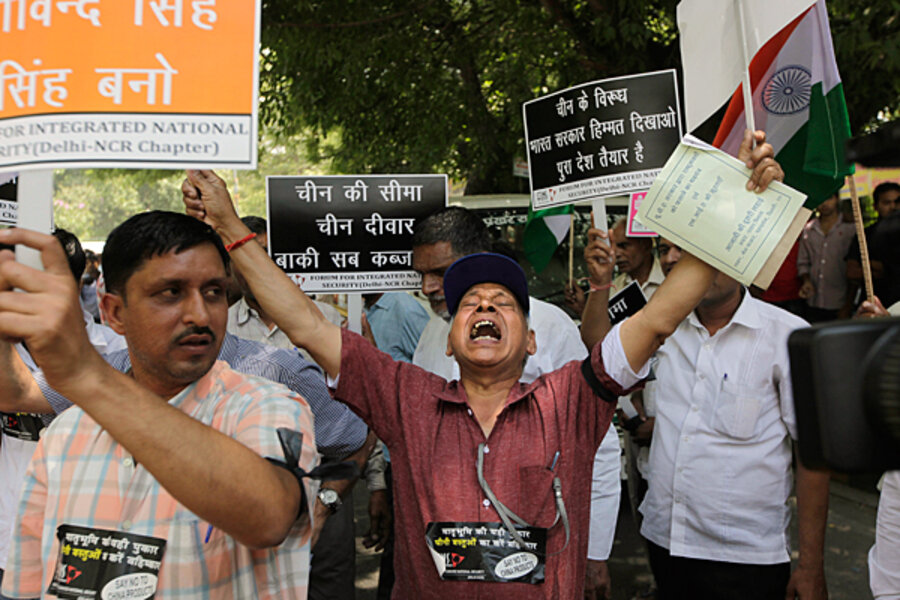Incursion or fair play? Chinese, Indian troops face off along disputed border.
Loading...
| Beijing
As Chinese and Indian troops face off again on a remote and barren Himalayan mountainside where the two sides fought a war 50 years ago, their governments are trying hard to play down the territorial dispute and prevent it from flaring into violence.
“It is a limited, localized incident in geography and scope,” insisted Indian Foreign Ministry spokesman Syed Akbarudin in Delhi on Thursday.
“China and India are wise and capable enough to handle the existing differences … while boosting friendly cooperation,” Mr. Akbarudin’s Chinese counterpart, Hua Chunying, said in Beijing.
But the standoff in disputed territory, now entering its third week, is threatening to derail preparations for a visit to Delhi later this month by new Chinese Premier Li Keqiang. His choice of India for his first foreign trip had seemed to signal a fresh turn in relations between the neighboring rivals.
Two weeks ago, a platoon of Chinese People’s Liberation Army soldiers pitched tents in an area near the Tibetan border over which China and India both claim sovereignty. India complained about what it called an incursion into its territory, and sent soldiers who then pitched their own tents less than 100 yards from the Chinese encampment.
Three rounds of “flag talks” – parleys between local military commanders – and diplomatic negotiations between Beijing and Delhi have so far failed to resolve the dispute. The Chinese unit, far from withdrawing, has been reinforced and resupplied, according to Indian officials.
'Problems inevitably arise'
China does not dispute the location of its soldiers, but claims they are in Chinese territory. “Chinese patrol troops have never crossed the line,” insisted Ms. Hua last week, but added that since the border had never been officially demarcated “problems inevitably arise one way or another.”
Since a brief border war in 1962, China and India have been separated by a “Line of Actual Control,” but where it runs is a matter of dispute. In northern Ladakh, extraordinarily harsh and high altitude desert country, a 12- to 15-mile-wide strip of no-man’s land claimed by both sides lies between the two countries’ differing versions of the Line of Actual Control. It is there that the current incident is playing out.
Neither country’s army is technically supposed to send patrols into this territory, but both acknowledge that they do so. Under a 2005 agreement, however, patrols that come across each other are meant to ignore each other so as to “avoid any unfriendly complications,” says Binod Singh, an Indian academic who teaches at Peking University’s South Asian Studies Center.
The Indians, accustomed to keeping an eye on passing Chinese patrols, were surprised when the PLA troops began to set up a camp on April 15, says Dr. Singh. Diplomatic overtures, flag talks, and a hurried visit to the site of the dispute by the Indian Army chief of staff then followed, but have failed to resolve the situation.
Chinese observers dismiss the spat, which has blown up in the wake of territorial disputes between China and several other neighbors, as insignificant. They say the close attention that the Indian media has paid to the incident has made it harder to resolve.
“This sort of thing has happened before,” says Ye Hailin, a South Asia analyst at the China Academy for Social Sciences, a government linked think tank. The PLA pitched tents “to show our stand on the issue” of territorial sovereignty, adds Dr. Ye. “Our military have always been there; they were following a pattern and they didn’t realize this would be a problem.”
“Since the border has never been officially delineated, both sides have different perceptions of the Line of Actual Control and both sides send out patrols …some unexpected incidents are natural,” adds Lan Jianxue, an India expert at the China Institute of International Studies, a think tank linked to the Foreign Ministry.
Meanwhile in India...
Indian observers are more suspicious. “It is not a coincidence that the Chinese made their move now, with Li Keqiang due to visit India in May,” says Singh. “They want to assert their power and their presence … as a bargaining chip.”
It is unclear what Beijing might be seeking in return for a withdrawal of its soldiers; Indian press reports say PLA officers have complained during their flag talks about Indian construction in disputed territory. But the Chinese authorities have not mentioned any such complaints.
Indian Foreign Minister Salman Khurshid is due in Beijing next week to prepare for the Chinese premier’s visit later this month to India, but he has warned that events might change his plans, and the Chinese government has not confirmed his trip here.
Border incidents similar to the current standoff have flared up episodically in the past, and have generally died down soon enough. Chinese analysts expect a similar outcome this time.
“Both governments share a deep consensus at a high level that they should not let their overall bilateral relations be hostage to the boundary question,” says Dr. Lan. “This unexpected incident has been localized and it will not affect our relationship.”
In India, however, where many still smart from the memory of military defeat at Chinese hands in 1962, the mood is more belligerent, warns Singh. “There is pressure on the Indian Army to do something tit-for-tat,” he says. “If that happens, who knows what kind of unfortunate event we might see.”








